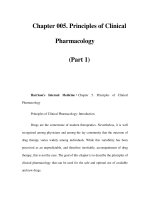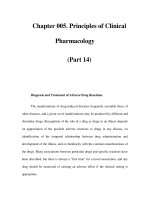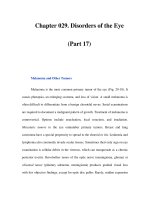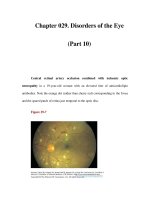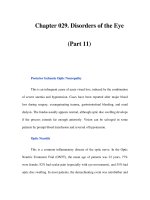Chapter 114. Molecular Mechanisms of Microbial Pathogenesis (Part 1) potx
Bạn đang xem bản rút gọn của tài liệu. Xem và tải ngay bản đầy đủ của tài liệu tại đây (13.63 KB, 5 trang )
Chapter 114. Molecular Mechanisms
of Microbial Pathogenesis
(Part 1)
Harrison's Internal Medicine > Chapter 114. Molecular Mechanisms of
Microbial Pathogenesis
Molecular Mechanisms of Microbial Pathogenesis: Introduction
Over the past three decades, molecular studies of the pathogenesis of
microorganisms have yielded an explosion of information about the various
microbial and host molecules that contribute to the processes of infection and
disease. These processes can be classified into several stages: microbial encounter
with and entry into the host; microbial growth after entry; avoidance of innate host
defenses; tissue invasion and tropism; tissue damage; and transmission to new
hosts. Virulence is the measure of an organism's capacity to cause disease and is a
function of the pathogenic factors elaborated by microbes. These factors promote
colonization (the simple presence of potentially pathogenic microbes in or on a
host), infection (attachment and growth of pathogens and avoidance of host
defenses), and disease (often, but not always, the result of activities of secreted
toxins or toxic metabolites). In addition, the host's inflammatory response to
infection greatly contributes to disease and its attendant clinical signs and
symptoms.
Microbial Entry and Adherence
Entry Sites
A microbial pathogen can potentially enter any part of a host organism. In
general, the type of disease produced by a particular microbe is often a direct
consequence of its route of entry into the body. The most common sites of entry
are mucosal surfaces (the respiratory, alimentary, and urogenital tracts) and the
skin. Ingestion, inhalation, and sexual contact are typical routes of microbial entry.
Other portals of entry include sites of skin injury (cuts, bites, burns, trauma) along
with injection via natural (i.e., vector-borne) or artificial (i.e., needlestick) routes.
A few pathogens, such as Schistosoma spp., can penetrate unbroken skin. The
conjunctiva can serve as an entry point for pathogens of the eye.
Microbial entry usually relies on the presence of specific microbial factors
needed for persistence and growth in a tissue. Fecal-oral spread via the alimentary
tract requires a biology consistent with survival in the varied environments of the
gastrointestinal tract (including the low pH of the stomach and the high bile
content of the intestine) as well as in contaminated food or water outside the host.
Organisms that gain entry via the respiratory tract survive well in small moist
droplets produced during sneezing and coughing. Pathogens that enter by venereal
routes often survive best on the warm moist environment of the urogenital mucosa
and have restricted host ranges (e.g., Neisseria gonorrhoeae, Treponema pallidum,
and HIV).
The biology of microbes entering through the skin is highly varied. Some
organisms can survive in a broad range of environments, such as the salivary
glands or alimentary tracts of arthropod vectors, the mouths of larger animals, soil,
and water. A complex biology allows protozoan parasites such as Plasmodium,
Leishmania, and Trypanosoma spp. to undergo morphogenic changes that permit
transmission to mammalian hosts during insect feeding for blood meals.
Plasmodia are injected as infective sporozoites from the salivary glands during
mosquito feeding. Leishmania parasites are regurgitated as promastigotes from the
alimentary tract of sandflies and are injected by bite into a susceptible host.
Trypanosomes are ingested from infected hosts by reduviid bugs, multiply in the
insects' gastrointestinal tract, and are released in feces onto the host's skin during
subsequent feedings. Most microbes that land directly on intact skin are destined
to die, as survival on the skin or in hair follicles requires resistance to fatty acids,
low pH, and other antimicrobial factors on skin. Once it is damaged (and
particularly if it becomes necrotic), the skin can be a major portal of entry and
growth for pathogens and elaboration of their toxic products. Burn wound
infections and tetanus are clear examples. After animal bites, pathogens resident in
the animal's saliva gain access to the victim's tissues through the damaged skin.
Rabies is the paradigm for this pathogenic process; rabies virus grows in striated
muscle cells at the site of inoculation.
Microbial Adherence
Once in or on a host, most microbes must anchor themselves to a tissue or
tissue factor; the possible exceptions are organisms that directly enter the
bloodstream and multiply there. Specific ligands or adhesins for host receptors
constitute a major area of study in the field of microbial pathogenesis. Adhesins
comprise a wide range of surface structures, not only anchoring the microbe to a
tissue and promoting cellular entry where appropriate but also eliciting host
responses critical to the pathogenic process (Table 114-1). Most microbes produce
multiple adhesins specific for multiple host receptors. These adhesins are often
redundant, are serologically variable, and act additively or synergistically with
other microbial factors to promote microbial sticking to host tissues. In addition,
some microbes adsorb host proteins onto their surface and utilize the natural host
protein receptor for microbial binding and entry into target cells.


